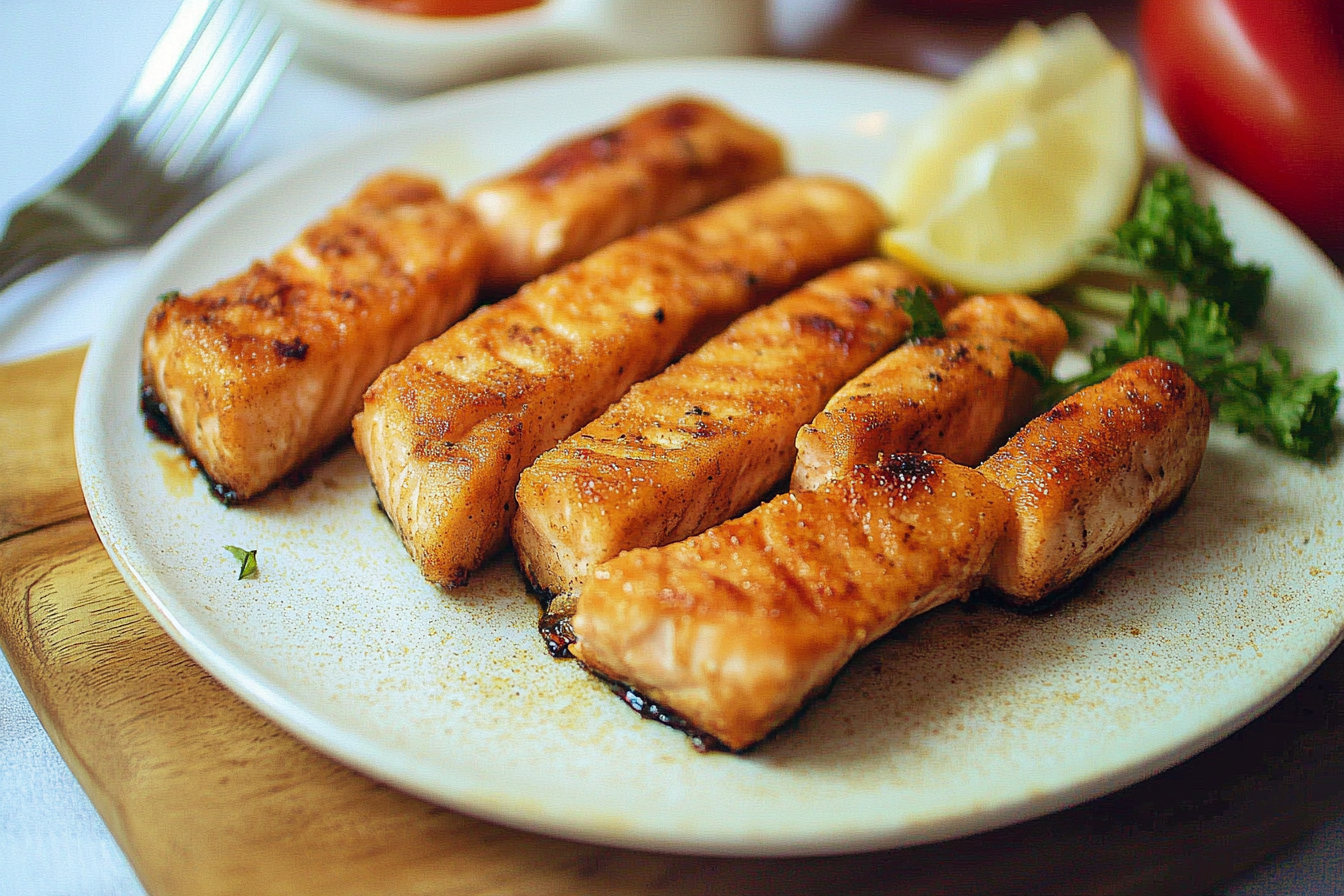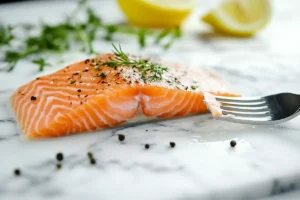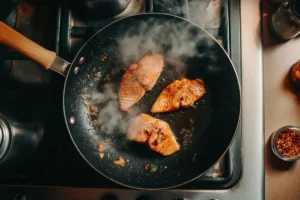Frying salmon perfectly requires understanding a few key points. This article will explore how long to fry salmon, offering tips for great results every time.
Frying Salmon: The Perfect Timing
Understanding how long should you fry salmon is critical for a great meal. The ideal cooking time depends on several factors, including the thickness of the fish and your desired level of doneness. However, generally, it won’t take long to cook a nice fillet of salmon.
Thickness Matters: Adjusting Frying Time
The thickness of your salmon is very important to consider. A thinner fillet will cook faster than a thicker one. Therefore, you should adjust the frying time accordingly. For instance, a one-inch thick salmon fillet might take about 3 to 5 minutes per side to fry. However, for a half-inch thick piece, it would be closer to 2 to 3 minutes per side. Accordingly, it’s crucial to check your salmon regularly while cooking.
Achieving Desired Doneness
Your preference for salmon doneness greatly influences how long to fry salmon. Some people like it slightly translucent in the center. Others prefer it fully cooked. Therefore, you must keep an eye on the cooking process. A good way to check is with a fork. The salmon should flake easily when it is done. Additionally, you can use a food thermometer. The internal temperature should reach 145°F (63°C). Ultimately, the goal is to cook your salmon just right.
Different Salmon Cuts and Their Cooking Times
Salmon comes in various cuts, each with different needs. How long to fry salmon depends greatly on the specific cut. Here’s a brief guide:
Salmon Fillets: The Most Common Cut
Fillets are the most popular cut of salmon. They typically have a uniform thickness. Consequently, they usually cook fairly evenly. A typical salmon fillet, about one inch thick, will need 3 to 5 minutes per side. However, always watch for the doneness level. The even thickness makes it a very flexible option.
Salmon Steaks: A Thicker Choice
Salmon steaks include a portion of the bone, making them slightly thicker than fillets. Therefore, the frying time might increase slightly. You will likely need around 4 to 6 minutes per side. Conversely, some people enjoy them cooked a bit less. The bone adds some extra flavor while it’s cooked. Basically, it’s all about preference.
Salmon Portions: Individual Serving Sizes
These cuts of salmon are often pre-cut for individual servings. They often vary in thickness. Thus, they require a little extra attention while frying. Use the same principle, adjusting the time based on thickness. Generally, they’ll take 2 to 5 minutes per side. Another tip is to check the thickest part of the fish.
Factors Influencing Salmon Frying Time
Several factors impact how long to fry salmon. Recognizing these will help you cook it to perfection every time.
Pan Temperature: The Key to Success
A medium-high pan is often best for frying salmon. A pan that’s too cool will result in uneven cooking. On the other hand, a pan that’s too hot will burn the fish. Therefore, ensure your pan is hot before adding the salmon. Furthermore, keep the temperature consistent. Use medium heat if you aren’t confident with higher temperatures. Subsequently, you will achieve perfect results with consistency.
Type of Oil: Selecting the Right One
The type of oil you use also matters when considering how long should you fry salmon. Oils with a high smoke point, such as canola or avocado oil, are great for frying. Olive oil can work, however, be careful as it can burn at high temperatures. The wrong oil can affect the flavor too. Indeed, it’s important to choose an oil wisely.
Skin-on vs. Skinless Salmon
Skin-on salmon requires a slightly different approach. When frying skin-on salmon, start skin-side down. This helps crisp the skin. Specifically, this can take a little longer to cook completely. However, it gives a nice, crisp texture. Skinless salmon, on the other hand, cooks faster overall. Altogether, it’s a matter of preference. If you prefer crispy skin, go for skin-on salmon.
Starting Temperature of Salmon
The starting temperature of the salmon also plays a role. If you take the salmon directly from the fridge, it might take slightly longer to cook through. Indeed, letting it sit at room temperature for about 15 to 20 minutes can help reduce the frying time. This simple step can make a big difference. Likewise, it ensures more even cooking.
The Type of Pan: An Additional Consideration
The pan itself can also change how long you should fry salmon. Different materials heat differently. Thicker pans might retain more heat and lead to slightly faster cooking times. Chiefly, cast iron retains heat very well. Thin pans might not maintain the heat as well. Comparatively, you may need slightly longer cooking times on thin pans.
Best Methods for Frying Salmon
There are several effective ways to fry salmon. Each method can affect the cooking time and the final outcome.
Pan-Frying Salmon: A Classic Approach
Pan-frying is a popular way to prepare salmon. Use a non-stick pan or a well-seasoned cast iron skillet. Heat your oil, then add the salmon. Subsequently, cook for the appropriate time per side. You’ll get a nice golden crust and a tender interior. The technique is simple, yet effective.
Using Butter: Enhancing Flavor
Adding butter to the pan as you fry enhances the richness of the salmon. However, watch the pan temperature closely. The butter can burn. This method requires extra attention. Equally, it adds a wonderful flavor. Some people use a combination of oil and butter. Specifically, this prevents the butter from burning.
High-Heat Searing: Quick and Crispy
High-heat searing is a great way to get a crispy skin on your salmon. Basically, you start with very hot oil and sear the skin side. Then reduce the heat to finish the cooking. This method can reduce the frying time slightly. Keep a close eye on the salmon while doing this. Moreover, it creates a great texture.
Using Different Pans: Considerations
The type of pan can affect how long you should fry salmon. Stainless steel pans can be great but may require more oil to prevent sticking. Non-stick pans are convenient, but they don’t always provide a good sear. Cast iron pans retain heat well. Thus, these are good choices for even cooking. A well-seasoned cast iron is fantastic for salmon. Indeed, it offers amazing heat distribution.
The Importance of Proper Prep
Before considering how long to fry salmon, proper preparation is essential. Ensure your salmon is dry before placing it in the pan. Patting it with paper towels helps achieve that crispy skin. Additionally, proper seasoning can greatly enhance the flavor. Consequently, do not skip this step.
Achieving a Perfect Sear
To get that golden brown sear, make sure the pan is hot before adding the salmon. Avoid moving it around too much initially. Let the salmon sit undisturbed. Afterward, the sear will develop perfectly. Once you have a good sear, you can flip it. Particularly, the first sear is crucial.
Serving Fried Salmon: Delicious Options
After frying your salmon perfectly, think about how you’ll serve it. There are many delicious choices.
With Lemon and Herbs: A Simple Classic
A simple squeeze of lemon juice and fresh herbs like dill or parsley pair wonderfully with fried salmon. This combination is always a hit. Furthermore, it’s easy to do. Fresh herbs add a nice touch. Specifically, this enhances the flavor.
With Roasted Vegetables: A Healthy Meal
Serving fried salmon with roasted veggies makes a balanced, healthy meal. Broccoli, asparagus, and bell peppers are great options. Specifically, they add color and nutrition. Roasted vegetables are easy to prepare. Likewise, they are a healthy option.
Over a Salad: A Light Choice
Fried salmon is delicious when served over a salad. Add some greens, tomatoes, cucumber, and a light dressing for a refreshing meal. Specifically, it’s great for a lighter lunch or dinner. This is a good option when trying to eat healthier. Moreover, it is versatile.
With Grains: A Hearty Option
Pair your fried salmon with grains like quinoa or brown rice for a more filling meal. This is a perfect option for a balanced dinner. Eventually, you’ll find your favorite pairings. Basically, it is about what you enjoy.
With a Creamy Sauce: An Indulgent Choice
A creamy dill or lemon sauce can elevate your fried salmon. These sauces can be prepared ahead of time. Specifically, it makes for an indulgent meal.
With a Simple Glaze: Adding Sweetness
A glaze made with honey or maple syrup can add a touch of sweetness. This complements the richness of the salmon. Undoubtedly, this can be a fun variation.
Exploring Flavor Combinations
Consider using different seasonings for your salmon. Garlic powder, paprika, and black pepper are great options. Moreover, you can experiment with different flavors. Additionally, use fresh herbs and spices.
Advanced Tips for Frying Salmon
To ensure success every time you fry salmon, consider these advanced tips:
Pre-Heating the Pan Correctly
Allow your pan to heat properly before adding any oil or salmon. A hot pan is essential for creating a good sear. Hence, this initial step is critical for success.
Avoiding Overcrowding the Pan
Do not overcrowd the pan with salmon. This can lower the temperature of the pan and result in uneven cooking. Therefore, cook the salmon in batches if needed.
Using a Thermometer for Accuracy
Using a food thermometer ensures the salmon is cooked to the correct temperature. Thus, this method is more precise than relying on visual cues. An internal temperature of 145°F (63°C) is recommended.
The Importance of Rest

Allow the salmon to rest for a few minutes after cooking. This allows the juices to redistribute. Consequently, the salmon will be even more moist.
Cleaning Your Pan Promptly
Clean your pan as soon as it cools down. Specifically, this helps avoid any residue. This makes it ready for your next meal.
Experimenting with Seasonings
Do not be afraid to try different seasonings. Lemon pepper, garlic salt, and paprika are great additions. Unquestionably, this is a wonderful way to personalize your meal.
Adding Flavor at the End
Consider adding flavor elements like lemon slices or fresh herbs at the end of the cooking process. This enhances the overall experience. Finally, this small step can make a big difference.
Perfecting Your Technique
The more you fry salmon, the better you’ll get. Ultimately, practice is the key to perfection.
Troubleshooting Common Frying Issues
Even experienced cooks can encounter problems. Here’s how to solve them:
Salmon Sticking to the Pan
If the salmon sticks, make sure the pan is hot enough before adding oil and fish. Avoid moving it until a crust forms. Basically, the pan needs to be at the right temperature.
Salmon Cooking Unevenly
This often happens if the pan’s heat isn’t uniform. Also, the salmon may be uneven in thickness. Therefore, ensure that the pan is hot and consider using a thermometer to check doneness.
Salmon is Too Dry
This usually means it’s overcooked. Lower the heat and reduce cooking time. Conversely, this can prevent drying. Make sure the internal temperature reaches 145°F (63°C).
Salmon is Not Crispy Enough
To get a crispy skin, start with skin-side down in a hot pan with oil. Do not move it until the skin is golden brown. Specifically, this helps create the crispy skin you desire.
Conclusion: Mastering the Art of Frying Salmon
Knowing how long to fry salmon is key for cooking it perfectly. Understanding the thickness, cut, and other factors will help you achieve the best results. With practice, you will master frying salmon and enjoy delicious meals. Remember to check for doneness and enjoy the flavors. Indeed, it’s a very rewarding experience.



